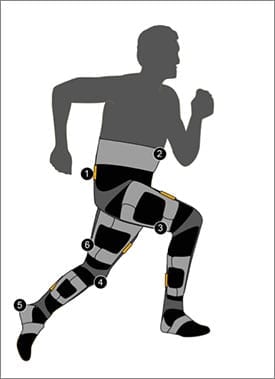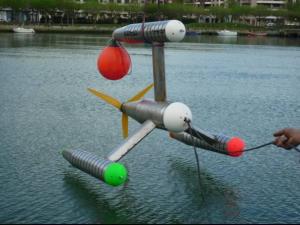
Details of a touchscreen showing 3D images that can be felt and manipulated have been published by Microsoft’s research unit.
The project combines an LCD flat panel screen with force sensors and a robotic arm that moves it back and forwards.
By controlling how much resistance there is to a user’s fingertip the firm says it can simulate the shape and weight of objects shown on screen.
Microsoft says the device could have medical uses as well as for gaming.
Work on the project is being carried out at the firm’s Redmond campus near Seattle.
Simulated shapes
When a person touches the prototype it pushes back with a light force to ensure one of their fingers stays in contact with the screen.
If they then press against it the robotic arm instantly pulls the screen backwards in a matching smooth movement. If they start to retract their finger, it moves it back towards them.
Meanwhile a computer adjusts the size and perspective of the on-screen graphics to create a 3D effect.
The trick to simulating a physical sense of touch is to adjust the amount of force-feedback resistance.

The screen can recreate the feel of an object’s shape by being moved backwards and forwards.
So, in an application which shows graphics representing different square blocks on a wall, a “stone” one requires a relatively large amount of force to push it off the ledge and a “sponge” one less.
In addition, the kit can be used to provide a sense of shape by adjusting the screen’s position to match a virtual object’s contours as a person drags their finger over its surface.
“As your finger pushes on the touchscreen and the senses merge with stereo vision, if we do the convergence correctly and update the visuals constantly so that they correspond to your finger’s depth perception, this is enough for your brain to accept the virtual world as real,” said senior researcher Michael Pahud.
His team have used the technique to allow users to feel the shape of a virtual cup and ball, among other objects, while viewing them using special glasses to get a stereo-vision effect.
Touch-and-find tumours
Microsoft suggests one use for the device would be to allow doctors to explore body scans.
The Latest Bing News on:
3D touchscreen
- I Tried the New iPad Pro's Nano-Texture Anti-Reflective Displayon May 8, 2024 at 1:50 pm
After Apple's “Let Loose” virtual event, I got to spend around 45 minutes with the new iPad Pros, specifically the version with the nano-texture display that reduces reflections and glare. Here are my ...
- E Ink: Spectra 6 won 2024 Display Industry Award from SIDon May 8, 2024 at 1:44 pm
The Society for Information Display has recently revealed the winners of its 30th Annual Display Industry Awards. These awards recognize the best displays, components, and applications introduced in ...
- ROG Ally mod adds an extra touchscreen for more Windows real estate and works as a handy standon May 8, 2024 at 7:50 am
Handheld gaming PCs are loved by many of us in the PC Gamer hardware office and I especially like the Asus ROG Ally. The only thing I wished it had was a bigger screen, as the 7-inch 1080p panel ...
- Homeschoolers display art at Nappanee Art Centeron May 7, 2024 at 5:00 pm
“I loved doing it, so I approached Mrs. Shaw about working together. She did the drawings and I did the 3D parts,” Daumen explained. The students had to prep the books. Using used books as a base, the ...
- Art, 3D printing among Rodman activities this monthon May 6, 2024 at 10:31 pm
Lessons for ages 6 to 8 will be 1 to 2 p.m., and lessons for ages 9 to 12 will be 2:30 to 4 p.m. An Art Gala with all projects on display will be 1 to 2 p.m. June 29 at the library, and all ...
- Nicki Minaj Puts On a Quirky Display in Canary Yellow Floral Appliqué Dress at the 2024 Met Galaon May 6, 2024 at 7:12 pm
Nicki Minaj looked stunning as she made her entrance on the 2024 Met Gala red carpet on Monday, May 6, in New York City ...
- Global 3D Metrology Market to Reach US$ 24.53 Billion by 2033 at 8.5% CAGR: Future Market Insights, Inc.on May 6, 2024 at 5:36 am
The 3D metrology industry is expected to be valued $10.85 billion in 2023, increasing to $24.53 billion by 2033. Between 2023 and 2033, the worldwide industry expanded at an 8.5% CAGR. To address ...
- This modder added a second display to ASUS ROG Ally gaming handheldon May 5, 2024 at 10:32 pm
One modder tweaks his ASUS ROG Ally gaming handheld with a second display: a 7-inch 1024 x 600 IPS display connected through HDMI.
- Tipton HS Art Show on display through May 10on May 5, 2024 at 1:30 am
The work of Tipton High School students is on display at the Tipton County Public Library. The annual art show exhibit displays visual images and 3D pieces. The exhibit is hosted by the National Honor ...
- Australian Museum Removes Mummified Body Parts From Displayon April 30, 2024 at 1:56 pm
Curators are also exhibiting a painted portrait from the Roman era. The completely wrapped, mummified bodies of individuals named Meruah and Horus are still on display, along with 3D visualizations ...
The Latest Google Headlines on:
3D touchscreen
[google_news title=”” keyword=”3D touchscreen” num_posts=”10″ blurb_length=”0″ show_thumb=”left”]
The Latest Bing News on:
Tactile feedback
- Best Mac Keyboards 2024on May 8, 2024 at 9:32 am
We compare Apple's Magic Keyboards - with and without Touch ID - with the best alternative Mac keyboards out there. Find the one that's best for you.
- Best Keyboard Switches For Gaming In 2024on May 8, 2024 at 9:00 am
Cherry MX Speeds are arguably the most popular keyboard switches in gaming today, and that's been the case for quite a while. These switches have lower spring resistance, 1.2mm pre-travel, and no ...
- How the New Apple Pencil Pro Is Like an Art Studio in a Beautiful Stickon May 8, 2024 at 8:35 am
The Apple Pencil Pro adds a ton of new features at the same price as the old model. Paired with the new iPad Pro, it's a portable production studio. No, Apple still hasn't put an eraser on the other ...
- Apple Pencil Pro launched in India at ₹11,900, features new squeeze gesture, haptic feedback, Find My feature, and moreon May 8, 2024 at 3:42 am
Alongside the iPad Air and iPad Pro new models, Apple has also introduced the Apple Pencil Pro at the iPad event to redefine the digital drawing experience.
- Tactile Systems Technology First Quarter 2024 Earnings: Revenues Beat Expectations, EPS Lagson May 8, 2024 at 3:11 am
For instance, we've identified 2 warning signs for Tactile Systems Technology that you should be aware of. Have feedback on this article? Concerned about the content? Get in touch with us directly.
- 2024 Apple Pencil Pro launches with squeeze sensor, haptic feedback engine and moreon May 8, 2024 at 1:37 am
Apple has created a new Apple Pencil Pro stylus to use with its latest generation of M4 iPad Pro tablets enabling users to sketch and draw ...
- Apple’s new Pencil Pro is nice, but it falls short of the iPad’s true promiseon May 7, 2024 at 11:16 am
Apple unveiled the new Apple Pencil Pro. It comes with handy features like haptic feedback, but without a more tactile iPad to go with it, the set up will never feel like a true pen-and-paper ...
- Tactile Actuator Market Size, Global Trends | Report 2024-2032on May 6, 2024 at 11:10 pm
(MENAFN- Meridian Market Consultants) The Reports and Insights, a leading market research company, has recently releases report titled “Tactile Actuator Market: Global Industry Trends, Share, Size, ...
- Tactile Systems Technology Inc.on May 5, 2024 at 5:00 pm
The Price to Earnings (P/E) ratio, a key valuation measure, is calculated by dividing the stock's most recent closing price by the sum of the diluted earnings per share from continuing operations ...
- New stretchable robot skin prevents tactile measurement errorson May 3, 2024 at 8:36 am
Artificial skin by Texan researchers is stretchable but avoids the issue of inaccurate knife bite simulations, offering precise tactile feedback.
The Latest Google Headlines on:
Tactile feedback
[google_news title=”” keyword=”tactile feedback” num_posts=”10″ blurb_length=”0″ show_thumb=”left”]










